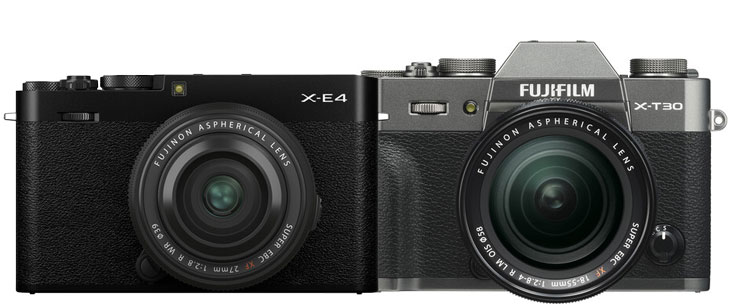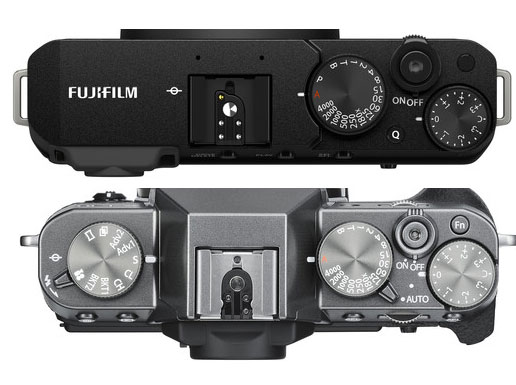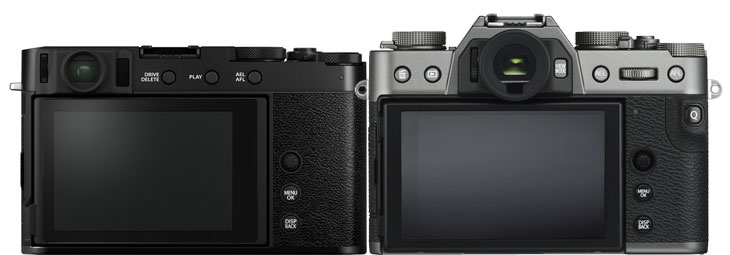
Fuji X-E4 vs Fuji X-T30 – Fuji X-T30 is one of the most popular cameras in the int’s price segment. After the announcement of the Fuji X-E4 camera I am getting lots of queries but uses that Should I buy Fuji F-Xt30 camera or wait for the Fuji X-E4 camera. We have compared the Fuji X-E4 versus Fuji X-T30 now let’s find out the best camera for you.
Fuji X E4 camera features almost identical core specifications as we have in the Fuji X-t30 camera. Even though there are a lot of similarities between the two, but we do some significant differences also. In this comparison review, we will be going to find out the major differences at why you should pick Fuji X-E4 camera instead of using xt30
1. Image sensor
The image sensor of both the camera is exactly the same, both cameras are using a future ultra popular and reliable 26 megapixels BSI CMOS X-Trans sensor. the sensor was first introduced in the Fuji X-T3 camera. After that, the 26-megapixel sensor used widely in Fuji flagship, midrange, and entry-level mirrorless camera systems. And finally, the X-E series of Fuji also got updated with the same sensor.

Fuji X-T30 offers more manual control than of Fuji X-E4 camera. Fuji better choice for still shooters.
| Fuji X-E4 | Fuji X-T30 | |
| Lens Mount | FUJIFILM X | FUJIFILM X |
| Camera Format | APS-C (1.5x Crop Factor) | APS-C (1.5x Crop Factor) |
| Sensor Resolution | Effective: 26.1 Megapixel (6240 x 4160) | Effective: 26.1 Megapixel |
| Aspect Ratio | 1:1, 3:2, 16:9 | 1:1, 3:2, 16:9 |
| Sensor Type | CMOS | CMOS |
| Sensor Size | 23.5 x 15.6 mm | 23.5 x 15.6 mm |
| Image File Format | JPEG, Raw | JPEG, Raw |
| Bit Depth | 14-Bit | 14-Bit |
| Image Stabilization | None | None |
2. Iso settings and more
Since the sensor is the same, and the image processor used inside both the camera is exactly the same so the ISO range of both Fuji xt30 and Fuji X-E4 camera remains exactly the same.
Fuji introduced a new mechanical shutter inside the Fuji X-E4 camera as you can see in the specs table below the range of the mechanical sector is increased.
Continuous shooting speed of both the camera or you can say the burst speed of both cameras is also exactly the same as of each other. Metering modes, exposure modes, and even the exposure compensation. each and every value of both the camera is exactly the same.

Fuji X-E4 features vlogging friendly screen and X-T30 viewfinder in the center, As a still shooter one should pick the X-T30, and for bloggers X-E4 is more recommended.
| Fuji X-E4 | Fuji X-T30 | |
| ISO Sensitivity | Auto, 160 to 12800 (Extended: 80 to 51200) | Auto, 160 to 12800 (Extended: 80 to 51200) |
| Shutter Speed | Mechanical Shutter 1/4000 to 3600 Seconds 1/4000 to 4 Seconds in Program Mode 1/4000 to 30 Seconds in Aperture Priority Mode 0 to 60 Minutes in Bulb Mode Electronic Shutter 1/32000 to 900 Seconds 1/32000 to 4 Seconds in Program Mode 1/32000 to 30 Seconds in Aperture Priority Mode 1 to 1 Second in Bulb Mode 1/4000 to 1/24 Second in Movie Mode |
Mechanical Shutter 1/4000 to 900 Seconds Electronic Shutter 1/32000 to 900 Seconds Electronic Front Curtain Shutter 0 to 60 Minutes in Bulb Mode |
| Metering Method | Average, Center-Weighted Average, Multi-Zone, Spot | Average, Center-Weighted Average, Multi-Zone, Spot |
| Exposure Modes | Aperture Priority, Manual, Program, Shutter Priority | Aperture Priority, Manual, Program, Shutter Priority |
| Exposure Compensation | -5 to +5 EV (1/3 EV Steps) | -5 to +5 EV (1/3 EV Steps) |
| White Balance | Automatic Scene Recognition, Color Temperature, Custom, Fine, Fluorescent (Cool White), Fluorescent (Daylight), Fluorescent (Warm White), Incandescent, Shade, Underwater | Automatic Scene Recognition, Color Temperature, Custom, Fine, Fluorescent (Cool White), Fluorescent (Daylight), Fluorescent (Warm White), Incandescent, Shade, Underwater |
| Continuous Shooting | Mechanical Shutter Up to 8 fps at 26.1 MP for up to 105 Frames (JPEG) / 18 Frames (Raw) Up to 5 fps at 26.1 MP for up to 458 Frames (JPEG) / 24 Frames (Raw) Up to 4 fps at 26.1 MP for Unlimited Frames (JPEG) / 28 Frames (Raw) Up to 3 fps at 26.1 MP for Unlimited Frames (JPEG) / 34 Frames (Raw) Electronic Shutter Up to 20 fps at 26.1 MP for up to 32 Frames (JPEG) / 17 Frames (Raw) Up to 10 fps at 26.1 MP for up to 81 Frames (JPEG) / 18 Frames (Raw) Electronic Shutter Up to 30 fps at 16.6 MP for up to 29 Frames (JPEG) / 17 Frames (Raw) Up to 20 fps at 16.6 MP for up to 79 Frames (JPEG) / 17 Frames (Raw) Up to 10 fps at 16.6 MP for up to 153 Frames (JPEG) / 18 Frames (Raw) |
Up to 8 fps at 26.1 MP for up to 90 Frames (JPEG) / 18 Frames (Raw) Up to 5 fps at 26.1 MP Up to 4 fps at 26.1 MP Up to 3 fps at 26.1 MP Up to 20 fps at 26.1 MP for up to 32 Frames (JPEG) / 17 Frames (Raw) Up to 10 fps at 26.1 MP for up to 81 Frames (JPEG) / 17 Frames (Raw) Up to 30 fps at 16.6 MP for up to 26 Frames (JPEG) / 17 Frames (Raw) Up to 20 fps at 16.6 MP for up to 53 Frames (JPEG) / 17 Frames (Raw) Up to 10 fps at 16.6 MP for up to 95 Frames (JPEG) / 18 Frames (Raw) |
| Interval Recording | Yes | Yes |
| Self-Timer | 2/10-Second Delay | 2/10-Second Delay |
3. Fuji X-E4 Recording Time Limit
The Fuji X-E4 camera features a full HD video recording option of 240 frames per, the Fuji X-T30 camera remains limited to 120FPS Full HD video mode.
One of the major differences between these two camera video modes is the recording time limit. As you can see in the specification table below, the Fuji X-T30 recording time limit of 4K and Full HD is variable. On the other side, we have the Fuji X-E4 Recording time limit is 30 Minutes in Full HD and 4k video modes.
Introduction of 240FPS @ Full HD in Fuji X-E4 camera. With the new 240FPS frame rates you can create super Slo-Mo Full HD videos. The Fuji X-T3 camera remains limited to 120FPS in Ful HD.
| Fuji X-E4 | Fuji X-T30 | |
| Recording Modes | H.264/MOV 4:2:0 8-Bit DCI 4K (4096 x 2160) at 23.976p/24.00p/25p/29.97p [100 to 200 Mb/s] UHD 4K (3840 x 2160) at 23.976p/24.00p/25p/29.97p [100 to 200 Mb/s] DCI 2K (2048 x 1080) at 23.976p/24.00p/25p/29.97p/50p/59.94p [50 to 200 Mb/s] Full HD (1920 x 1080) at 23.976p/24.00p/25p/29.97p/50p/59.94p/100p/119.88p/200p/239.76p [100 to 200 Mb/s] |
MOV/H.264 DCI 4K (4096 x 2160) at 23.976p/24.00p/25p/29.97p [100 to 200 Mb/s] UHD 4K (3840 x 2160) at 23.976p/24.00p/25p/29.97p [100 to 200 Mb/s] DCI 2K (2048 x 1080) at 23.976p/24.00p/25p/29.97p/50p/59.94p [100 to 200 Mb/s] Full HD (1920 x 1080) at 23.976p/24.00p/25p/29.97p/50p/59.94p [100 to 200 Mb/s] Full HD (1920 x 1080) at 100p/119.88p [200 Mb/s] |
| External Recording Modes | 4:2:2 10-Bit DCI 4K (4096 x 2160) at 23.976p/24.00p/25p/29.97p UHD 4K (3840 x 2160) at 23.976p/24.00p/25p/29.97p DCI 2K (2048 x 1080) at 23.976p/24.00p/25p/29.97p/50p/59.94p Full HD (1920 x 1080) at 23.976p/24.00p/25p/29.97p/50p/59.94p/100p/120p |
4:2:2 10-Bit DCI 4K (4096 x 2160) at 23.976p/24.00p/25p/29.97p UHD 4K (3840 x 2160) at 23.976p/24.00p/25p/29.97p DCI 2K (2048 x 1080) at 23.976p/24.00p/25p/29.97p/50p/59.94p Full HD (1920 x 1080) at 23.976p/24.00p/25p/29.97p/50p/59.94p Full HD (1920 x 1080) at 100p/120p |
| Recording Limit | Up to 30 Minutes | Up to 10 Minutes for DCI 4K (4096 x 2160) Up to 10 Minutes for UHD 4K (3840 x 2160) Up to 15 Minutes for DCI 2K (2048 x 1080) Up to 15 Minutes for Full HD (1920 x 1080) |
| 240p / 200p 200Mbps(recording) up to approx. 3min. 120p / 100p 200Mbps(recording) up to approx. 6min. |
[Full HD(1920×1080) High speed rec.] 120p/100p 200Mbps(recording) up to approx. 6min. |
|
| Recording Time Limit Details | [DCI 4K(4096 x 2160)] 29.97p/25p/24p/23.98p 200Mbps/100Mbps up to approx. 30min. [4K(3840 x 2160)] 29.97p/25p/24p/23.98p 200Mbps/100Mbps up to approx. 30min. [Full HD(2048 x 1080)] 59.94p/50p/29.97p/25p/24p/23.98p 200Mbps/100Mbps/50Mbps up to approx. 30min. [Full HD(1920 x 1080)] 59.94p/50p/29.97p/25p/24p/23.98p 200Mbps/100Mbps/50Mbps up to approx. 30min. [Full HD(1920 x 1080) High speed rec.] |
[DCI 4K(4096×2160)] 29.97p/25p/24p/23.98p 200Mbps/100Mbps up to approx. 10min[4K(3840×2160)] 29.97p/25p/24p/23.98p 200Mbps/100Mbps up to approx. 10min[Full HD(2048 ×1080)] 59.94p/50p/29.97p/25p/24p/23.98p 200Mbps/100Mbps up to approx. 15min.[Full HD(1920×1080)] 59.94p/50p/29.97p/25p/24p/23.98p 200Mbps/100Mbps up to approx. 15min. |
| Video Encoding | NTSC/PAL | NTSC/PAL |
| Audio Recording | Built-In Microphone (Stereo) External Microphone Input |
Built-In Microphone (Stereo) External Microphone Input |
| Audio File Format | Linear PCM (Stereo) | Linear PCM (Stereo) |
4. Autofocus Modes
The Fuji X-E4 camera arrived with upscaled AF algorithms, which includes enhanced object tracking in video mode and AF lock speed, just like we have in the Fuji X-T4 Mirrorless camera.
| Fuji X-E4 | Fuji X-T30 | |
| Focus Type | Auto and Manual Focus | Auto and Manual Focus |
| Focus Mode | Continuous-Servo AF (C), Manual Focus (M), Single-Servo AF (S) | Continuous-Servo AF (C), Manual Focus (M), Single-Servo AF (S) |
| Autofocus Points | Phase Detection: 425 | Phase Detection: 425 |
4. Size and weight
Size-wise we have very little difference between the two and the same with the weight of both the camera.s
| Fuji X-E4 | Fuji X-T30 | |
| Battery | 1 x NP-W126S Rechargeable Lithium-Ion, 7.2 VDC, 1260 mAh (Approx. 380 Shots) | 1 x NP-W126S Rechargeable Lithium-Ion, 7.2 VDC, 1260 mAh |
| Dimensions (W x H x D) | 4.8 x 2.9 x 1.3″ / 121.3 x 72.9 x 32.7 mm | 4.7 x 3.3 x 1.8″ / 118.4 x 82.8 x 46.8 mm |
| Weight | 12.8 oz / 364 g (Body with Battery and Memory) | 13.51 oz / 383 g (Body with Battery and Memory) |
Verdict: For Photographers the Fuji X-T30 camera will be more suitable since the still specification is almost the same, but the X-T30 has a bit better design and viewfinder placement. For VLoggers and videographers/cinematographers Fuji X-E4 is an excellent choice.








